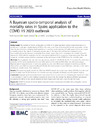Identificador persistente para citar o vincular este elemento:
https://accedacris.ulpgc.es/jspui/handle/10553/107534
| Título: | A Bayesian spatio-temporal analysis of mortality rates in Spain: application to the COVID-19 2020 outbreak | Autores/as: | Saavedra Santana, Pedro Santana Del Pino, Ángelo Bello, Luis Pacheco Castelao, José Miguel Sanjuán Velázquez, Esther |
Clasificación UNESCO: | 320505 Enfermedades infecciosas 240401 Bioestadística |
Palabras clave: | Covid-19 Excess Of Deaths Integrated Nested Laplace Approximation Spatio-Temporal Models Standardized Mortality Ratios |
Fecha de publicación: | 2021 | Publicación seriada: | Population Health Metrics | Resumen: | Background: The number of deaths attributable to COVID-19 in Spain has been highly controversial since it is problematic to tell apart deaths having COVID as the main cause from those provoked by the aggravation by the viral infection of other underlying health problems. In addition, overburdening of health system led to an increase in mortality due to the scarcity of adequate medical care, at the same time confinement measures could have contributed to the decrease in mortality from certain causes. Our aim is to compare the number of deaths observed in 2020 with the projection for the same period obtained from a sequence of previous years. Thus, this computed mortality excess could be considered as the real impact of the COVID-19 on the mortality rates. Methods: The population was split into four age groups, namely: (< 50; 50–64; 65–74; 75 and over). For each one, a projection of the death numbers for the year 2020, based on the interval 2008–2020, was estimated using a Bayesian spatio-temporal model. In each one, spatial, sex, and year effects were included. In addition, a specific effect of the year 2020 was added ("outbreak"). Finally, the excess deaths in year 2020 were estimated as the count of observed deaths minus those projected. Results: The projected death number for 2020 was 426,970 people, the actual count being 499,104; thus, the total excess of deaths was 72,134. However, this increase was very unequally distributed over the Spanish regions. Conclusion: Bayesian spatio-temporal models have proved to be a useful tool for estimating the impact of COVID-19 on mortality in Spain in 2020, making it possible to assess how the disease has affected different age groups accounting for effects of sex, spatial variation between regions and time trend over the last few years. | URI: | https://accedacris.ulpgc.es/handle/10553/107534 | ISSN: | 1478-7954 | DOI: | 10.1186/s12963-021-00259-y | Fuente: | Population Health Metrics [EISSN 1478-7954], v. 19 (1), 27, (Diciembre 2021) |
| Colección: | Artículos |
Citas SCOPUSTM
10
actualizado el 08-jun-2025
Citas de WEB OF SCIENCETM
Citations
11
actualizado el 08-jun-2025
Visitas
121
actualizado el 03-ago-2024
Descargas
152
actualizado el 03-ago-2024
Google ScholarTM
Verifica
Altmetric
Comparte
Exporta metadatos
Los elementos en ULPGC accedaCRIS están protegidos por derechos de autor con todos los derechos reservados, a menos que se indique lo contrario.
